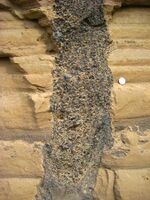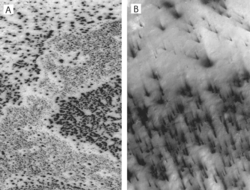Earth:Sand geyser

A sand geyser, sand fountain or sand blow is a geologic phenomenon which occurs in association with earthquakes and other seismic events.[1] In the geologic record, these are seen as clastic dikes.[2] It is described as "a geyser of sand and water that shoots from the ground during a major earthquake."[2][3] A quake can cause underlying sand to liquefy while pressure forces the eruption of the sand mixture to the surface.[4][5] The mixture of sand and water can also contain dissolved gases such as methane and carbon dioxide.[5]
Some investigators have located soil formations that indicate the existence of past sand geysers in earthquake prone areas.[1]
NASA has proposed that the existence of sand geysers on the surface of Mars explains some of the seasonal variations of light and dark areas. Plume-like markings that begin to appear during the martian spring may be caused by solid CO2 transforming explosively into its gaseous state causing an eruption of soil materials.[6]
A 2008 video recorded one eruption in Saudi Arabia.[7] Another lay commentator attributed a similar event to differences in air temperature between underground pockets of air and the air above the ground.[8] The phenomenon was observed during an earthquake in New Zealand in 1987.[9]
References
- ↑ 1.0 1.1 "The Great Midwest Earthquake of 1811" (in en). Smithsonian. https://www.smithsonianmag.com/science-nature/the-great-midwest-earthquake-of-1811-46342/.
- ↑ 2.0 2.1 Munday, Dave. "Old sand geyser shows quakes part of life here" (in en). Post and Courier. https://www.postandcourier.com/news/old-sand-geyser-shows-quakes-part-of-life-here/article_08de2dc5-19c2-56ca-a327-a15908f43bab.html.
- ↑ Freeland, Robert (2007). "GroundScan Projects". http://web.utk.edu/~freeland/projects/sb.htm.
- ↑ "Peril of 'Quicksand' Phenomenon in Quake Cited" (in en-US). Los Angeles Times. Associated Press. 1986-03-27. ISSN 0458-3035. http://articles.latimes.com/1986-03-27/news/mn-807_1_liquefaction.
- ↑ 5.0 5.1 Capaccioni, Bruno; Coltorti, Massimo; Todesco, Micol; Cremonini, Stefano; Giuseppe, Dario Di; Faccini, Barbara; Tessari, Umberto (2017). "Sand volcano generated by a violent degassing from methane-saturated aquifers: The case study of Medolla (Modena, Italy)". Engineering Geology 221: 91–103. doi:10.1016/j.enggeo.2017.02.027. Bibcode: 2017EngGe.221...91C.
- ↑ "Sand geysers could explain mystery spots on Mars" (in en-US). New Scientist. https://www.newscientist.com/article/dn9765-sand-geysers-could-explain-mystery-spots-on-mars/.
- ↑ "Sand Geyser - Wierd Natural Phenomenon ?". http://www.theworldgeography.com/2011/01/sand-geyser-wierd-natural-phenomena.html.
- ↑ "Video: Giant 'Sand Geyser' Erupts in Saudi Arabia - Coast to Coast AM" (in en). Coast to Coast AM. https://www.coasttocoastam.com/article/video-giant-sand-geyser-erupts-in-saudi-arabia.
- ↑ GRAPES, Rodney H. (1987). "Faulting and subsidence during the Edgecumbe earthquake, March 2, 1987, New Zealand." (in en). Journal of Physics of the Earth 35 (6): 415–423. doi:10.4294/jpe1952.35.415. ISSN 0022-3743.
External links
- Weiss, Peter (2004-07-10). "Grainy Geyser". Science News 166 (2): 19–20. doi:10.2307/4015516.
 |


